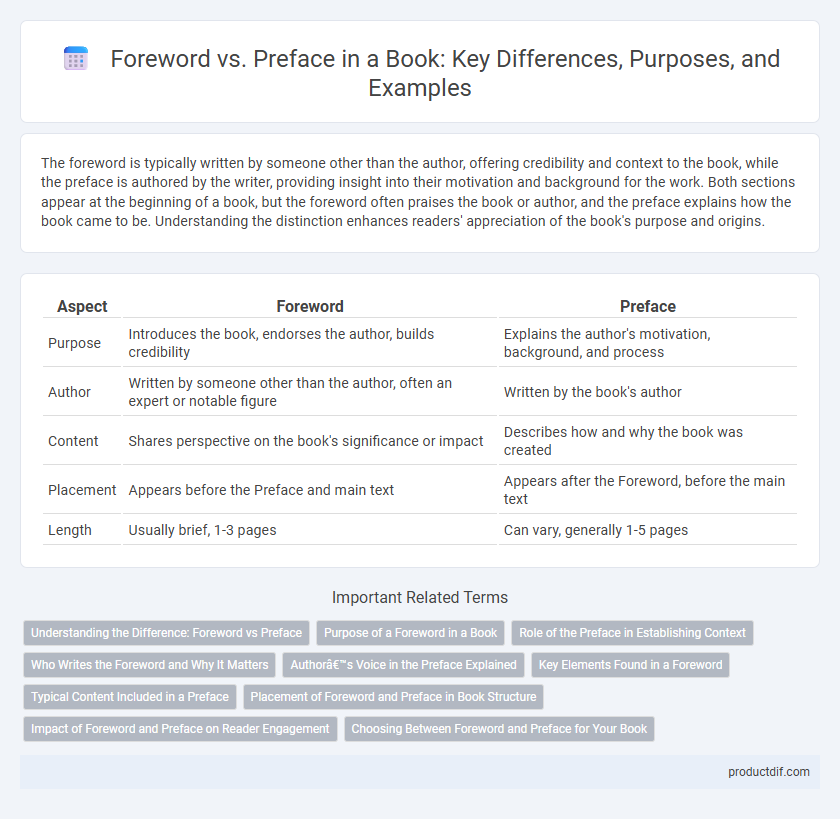The foreword is typically written by someone other than the author, offering credibility and context to the book, while the preface is authored by the writer, providing insight into their motivation and background for the work. Both sections appear at the beginning of a book, but the foreword often praises the book or author, and the preface explains how the book came to be. Understanding the distinction enhances readers' appreciation of the book's purpose and origins.
Table of Comparison
| Aspect | Foreword | Preface |
|---|---|---|
| Purpose | Introduces the book, endorses the author, builds credibility | Explains the author's motivation, background, and process |
| Author | Written by someone other than the author, often an expert or notable figure | Written by the book's author |
| Content | Shares perspective on the book's significance or impact | Describes how and why the book was created |
| Placement | Appears before the Preface and main text | Appears after the Foreword, before the main text |
| Length | Usually brief, 1-3 pages | Can vary, generally 1-5 pages |
Understanding the Difference: Foreword vs Preface
A foreword is typically written by someone other than the author, providing credibility or context from an external perspective, while a preface is authored by the book's writer, explaining the motivation, scope, or background of the work. Both sections appear before the main text but serve distinct purposes: the foreword offers an endorsement or insight from a knowledgeable source, whereas the preface addresses the author's intent and process. Understanding this difference helps readers better appreciate the origin and framing of the content within a book.
Purpose of a Foreword in a Book
A foreword in a book serves to introduce the author's work from the perspective of an expert or notable figure, establishing credibility and context for readers. It often highlights the significance of the content, offering endorsements and personal insights that enhance the book's value. Unlike a preface, the foreword is typically written by someone other than the author, providing an external viewpoint that frames the book's importance.
Role of the Preface in Establishing Context
The preface plays a crucial role in establishing context by providing the author's intent, background information, and the circumstances under which the book was written. Unlike the foreword, which is typically written by someone other than the author to endorse the work, the preface offers direct insight into the creative process and objectives. This helps readers understand the framework and purpose before delving into the main content.
Who Writes the Foreword and Why It Matters
A foreword is typically written by a respected expert, influential figure, or someone with a connection to the author, lending credibility and context to the book. This endorsement helps establish trust and attracts readers by highlighting the book's significance within its field. Understanding who writes the foreword and their authority enhances the reader's appreciation and anticipation of the content.
Author’s Voice in the Preface Explained
The author's voice in the preface offers a personal narrative that connects readers directly to the motivation and context behind the book's creation, distinguishing it from the foreword typically written by someone else. This section reflects the author's unique insights, experiences, and intentions, providing a deeper understanding of the book's purpose and thematic focus. Emphasizing authenticity and personal engagement, the preface serves as a bridge between the author's perspective and the reader's journey.
Key Elements Found in a Foreword
A foreword typically features an endorsement by a notable figure, providing credibility and context for the reader, often highlighting the author's expertise or the book's significance. It includes personal insights or experiences related to the book's subject, enhancing the reader's connection to the content. Unlike a preface, a foreword is usually written by someone other than the author and precedes the main text to prepare the audience for the forthcoming material.
Typical Content Included in a Preface
A preface typically includes the author's motivation for writing the book, acknowledgments of those who contributed to the work, and the book's development process. It often provides context about the creation, research challenges, and scope, setting expectations for the reader. Unlike a foreword, which is usually written by someone other than the author, the preface offers direct insight from the author's perspective.
Placement of Foreword and Preface in Book Structure
The foreword is typically placed at the very beginning of a book, before the preface and main text, serving as an introduction often written by someone other than the author. The preface follows the foreword and offers the author's personal perspective on the book's creation, purpose, or acknowledgments. Understanding the placement of the foreword and preface helps clarify their distinct roles in the book's overall structure.
Impact of Foreword and Preface on Reader Engagement
The foreword establishes credibility by featuring endorsements from authoritative figures, immediately capturing reader interest and setting expectations for the book's value. In contrast, the preface offers personal insights from the author, creating a connection by explaining the motivation and background behind the work. Both elements enhance reader engagement but achieve this through distinct approaches--forewords build trust and anticipation, while prefaces foster intimacy and contextual understanding.
Choosing Between Foreword and Preface for Your Book
Choosing between a foreword and a preface depends on the purpose and content of the introductory text in a book. A foreword is typically written by someone other than the author, offering credibility and endorsement, while a preface is authored by the writer, explaining the book's genesis, scope, or objectives. Understanding these differences aids authors in selecting the appropriate introduction to enhance reader engagement and establish context effectively.
Foreword vs Preface Infographic

 productdif.com
productdif.com